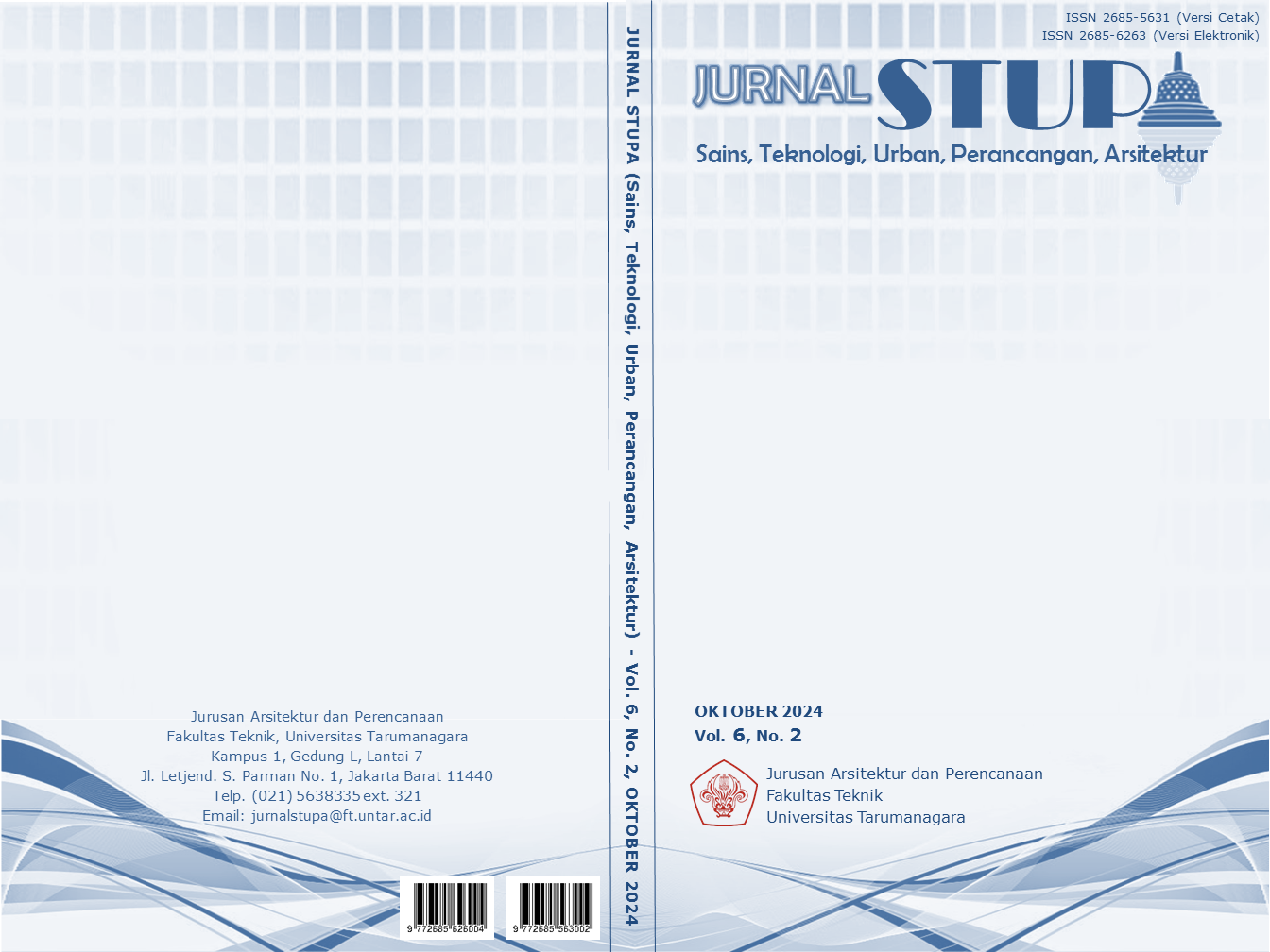PENERAPAN KONSEP TERAS PADA RUANG KOMUNITAS SEBAGAI SRATEGI MENGHIDUPKAN KEMBALI MAKNA TEMPAT DI LITTLE TOKYO BLOK M
Main Article Content
Abstract
Little Tokyo, which is located in the Blok M area, is one of the entertainment venues that is popular with young people in Jakarta. This area has a historical background as a place for Japanese people in Jakarta. The Japanese community has a culture of spending time at entertainment venues after a long day of work. This culture was carried over by Japanese people in Jakarta and was the beginning of why Little Tokyo was formed. Initially, this area was dominated by culinary places, bars and karaoke, offices, and others. However, as time goes by, there is a decrease in the number of native Japanese people who are still in Jakarta, so that Little Tokyo increasingly loses its meaning as a place. The aim of the research is to explore design approaches that can revive Little Tokyo as a place or forum for a community of Japanese culture lovers. The method used is a qualitative descriptive method by tracing the influence of Japanese culture in the Little Tokyo area through observation, starting from physical elements such as buildings to non-physical elements such as activities. This research resulted in the application of the terrace concept in Little Tokyo. The terrace concept can be related to the location of the site as a gate or entrance to the Little Tokyo area. The terrace concept also creates open space on several connected floors. The terrace concept is related to the Japanese cultural activity program and has been accepted by Indonesian culture.
Keywords: community; Japan; terrace
Abstrak
Little Tokyo yang terletak di Kawasan Blok M merupakan salah satu tempat hiburan yang digemari oleh kalangan anak muda di Jakarta. Kawasan ini memiliki latar belakang sejarah sebagai tempat bagi orang-orang Jepang di Jakarta. Komunitas Jepang tersebut memiliki budaya untuk menghabiskan waktu ke tempat hiburan setelah seharian bekerja. Budaya tersebut terbawa oleh orang Jepang yang ada Jakarta dan menjadi awal mengapa Little Tokyo ini terbentuk. Awalnya, kawasan ini didominasi oleh tempat kuliner, bar dan karaoke, kantor, dan lainnya. Namun seiring berjalannya waktu, terjadi penurunan jumlah orang asli Jepang yang masih berada di Jakarta sehingga Little Tokyo semakin kehilangan makna tempatnya. Tujuan penelitian adalah untuk menelusuri pendekatan perancangan yang dapat membangkitkan kembali Little Tokyo sebagai tempat atau wadah bagi komunitas pecinta budaya Jepang. Metode yang dilakukan adalah metode deskriptif kualitatif dengan melakukan penelusuran terhadap pengaruh budaya Jepang di kawasan Little Tokyo melalui observasi, mulai dari unsur fisik seperti bangunan sampai pada nonfisik seperti kegiatan. Penelitian ini menghasilkan penerapan konsep teras di Little Tokyo. Konsep teras dapat berhubungan dengan letak site sebagai Gate atau pintu masuk kawasan Little Tokyo. Konsep teras juga menciptakan ruang terbuka di beberapa lantai yang saling terkoneksi. Konsep teras berhubungan terhadap program aktivitas budaya orang Jepang dan sudah diterima oleh budaya orang Indonesia.
Article Details

This work is licensed under a Creative Commons Attribution-NonCommercial-ShareAlike 4.0 International License.
This work is licensed under a Jurnal Sains, Teknologi, Urban, Perancangan, Arsitektur/ STUPA Creative Commons Attribution-NonCommercial-ShareAlike 4.0 International LicenseReferences
Gregory, M., & Finlayson, C. (2019). The paradox of Cracker Barrel: A case study on place and placelessness. Advances in Hospitality and Tourism Research (AHTR), 7(2), 258-276.
Gupta, P. (2019). Relevance of Terrace Space in Architecture. International Journal of Research and Analytical Reviews, 6(1), 1345-1352.
Hutagalung, M., & Lianto, F. (2023). MEMORI KOLEKTIF KAWASAN “LITTLE TOKYO” PADA “TEMPAT KETIGA” BLOK M. Jurnal Sains, Teknologi, Urban, Perancangan, Arsitektur (Stupa), 5(1), 133-144.
Kompas.tv. (2023, Juli 30). Mengenang Laku "Ngeceng" di Little Tokyo Blok M.
Merdeka.com. (2016). Sisi Gelap Kecil di Blok M. Merdeka.com.
Prameswari, A. D. (2020, Desember 3). Menilik Perjalanan Little Tokyo di Kawasan Blok M. Menilik Perjalanan Little Tokyo di Kawasan Blok M.
Relph, E. (1976). Place and placelessness. Pion Limited.
Seamon, D., & Sowers, J. (1992). Place and Placelessness (1976). Key texts in human geography.
Syiariel, T. (2022, Maret 8). Jelajah "Little Tokyo" di Blok M, Jakarta Selatan.
Yulia. (2023, April 28). Tak Perlu Keluar Negeri, Little Tokyo Blok M Bisa Jadi Destinasi Kamu Berburu Makanan Jepang!



